View in other NatureServe Network Field Guides
NatureServe
Montana
Utah
Wyoming
Idaho
Wisconsin
British Columbia
South Carolina
Yukon
California
New York
Shortface Lanx - Fisherola nuttalli
State Rank Reason (see State Rank above)
Based on repeated surveys of historic habitat this species appears to be declining precipitously and is at great risk of extirpation within Montana due to ongoing threats to persistence of the population isolated by damming of the Clark Fork River.
- Details on Status Ranking and Review
Shortface Lanx (Fisherola nuttalli) Conservation Status Review
Review Date = 10/31/2019
Population Size
ScoreU - Unknown
CommentUnknown. 2019 surveys found 2 individuals at one site
Area of Occupancy
CommentHistoric and current populations have been found along a 24 km section of the lower Clark Fork River which includes areas of unsuitable habitat in Thompson Falls Reservoir. The existence of the upstream population is in question after 2019 survey did not detect the species. Currently one single population exists within a 0.5 km section of river between Thompson Falls and Noxon Reservoirs.
Length of Occupancy
ScoreLA - <4 km (less than about 2.5 miles)
Long-term Trend
ScoreU - Unknown. Long-term trend in population, range, area occupied, or number or condition of occurrences unknown
CommentHistoric data to assess declines are unavailable for this time frame. Damming of the river and other anthropogenic factors may have caused a decline in habitat but we are unable to assess the extent habitat has changed
Short-term Trend
ScoreA - Severely Declining. Decline of >70% in population, range, area occupied, and/or number or condition of occurrences
CommentRecent surveys of the area known to be occupied by the species found only one site with two individuals present. As sites were revisited confidence in absence within portions of its historic range is high.
Threats
ScoreA - Substantial, imminent threat. Threat is moderate to severe and imminent for most (>60%) of the population or area.
CommentThreatened by impoundment and damming (Frest and Johannes 1995). Specific threats to populations of Fisherola nuttalli have been identified as loss of habitat through impoundments, degraded water quality and siltation of cobbles, as well as nutrient enrichment. Effluence from agriculture, industry, and urban and residential developments has reduced water quality in much of the known range (Frest 1999).
SeverityHigh - Loss of species population (all individuals) or destruction of species habitat in area affected, with effects essentially irreversible or requiring long-term recovery (>100 years).
CommentIf extant populations are extirpated, recovery is not expected in less than 100 years, if it occurs at all.
ScopeHigh - > 60% of total population or area affected
CommentAs the range of the species in Montana is within a portion of one drainage threats are operational for the entire population.
ImmediacyHigh - Threat is operational (happening now) or imminent (within a year).
CommentOngoing
Intrinsic Vulnerability
ScoreB - Moderately Vulnerable. Species exhibits moderate age of maturity, frequency of reproduction, and/or fecundity such that populations generally tend to recover from decreases in abundance over a period of several years (on the order of 5-20 years or 2-5 generations); or species has moderate dispersal capability such that extirpated populations generally become reestablished through natural recolonization (unaided by humans).
CommentProduced a robust quantity of young across the spring, summer, and fall, but as the species lacks a free-swimming larval stage dispersal ability is limited (Hyman 1967)
Environmental Specificity
ScoreB - Narrow. Specialist. Specific habitat(s) or other abiotic and/or biotic factors (see above) are used or required by the Element, but these key requirements are common and within the generalized range of the species within the area of interest.
CommentSpecies specialized moderately sized streams to larger rivers and is only found on specific substrates and conditions.
Raw Conservation Status Score
Score
3.5 + Geographic Distribution LA(-1.0) + Environmental Specificity B (0.0) + Trends A (-1.0) + Threats A (-1.0) = 0.5
General Description
Fisherola nuttalli is a member of the Lymnaeidae family, a diverse group of small to large air-breathing pulmonate freshwater snails including 61 North American species in nine genera (Johnson et al. 2013). It is readily distinguished from all other freshwater snails living in the Columbia River drainage of Canada and the US by its "volcano-shaped" shell shape. Fisherola nuttalli is not a “true limpet”, but the common name “limpet” is applied to this species based on the limpet-like appearance (having a simple shell which is conical in shape rather than being spirally coiled). These snails are generally triangular-shaped being ~12 mm in length, 10 mm in width and 6 mm in height.
Diagnostic Characteristics
Accentric conical shell up to 0.5 inches long, 0.4 inches wide, and 0.2 inches high (Neitzel and Frest 1989). Shell small, solid, roundly ovate, slightly broader posteriorly, high-arched, apex posterior; finely concentrically striate, depressed conic (Hannibal 1912). "Shell coarse, somewhat ponderous, wide, ovate, elevated; lines of growth conspicuous; apex eroded, placed far back: anterior and lateral slopes convex, posterior slope steep and rectilinear. Color opaque chestnut-brown. Dimensions: 8 mm long, 6.25 mm wide, 3 mm high."
Species Range
Montana Range
Range Descriptions
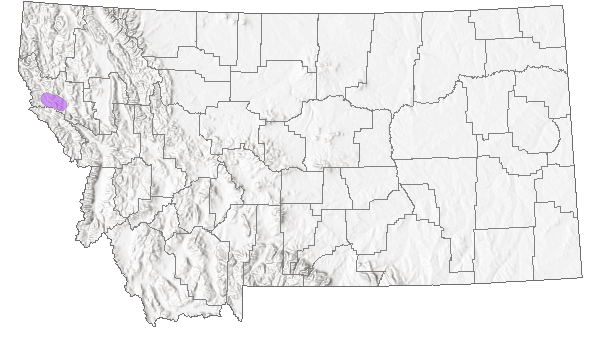
 Native
Native
Range Comments
Limited to tributaries of lower Columbia River (Frest and Johannes 1995). Rangewide, Fisherola nuttalli is found in scattered localities in the Columbia River drainage system of the Pacific Northwest, including Idaho, Washington, Oregon, and possibly Montana. Its presence in the Columbia River drainage in British Columbia is assumed from the discovery of a shell (Clarke 1981). Occurrences are still reported in the Okanagan River drainage in British Columbia and confirmed in the Deschutes River of Oregon (Neitzel and Frest 1990), Snake River (*Middle Snake River-downstream of Hells Canyon Dam-ID/OR).
In Idaho they are reported from Elmore, Gooding, Idaho, Nez Perce and Twin Falls Counties. Populations within Idaho persist in parts of the Salmon and Snake rivers (Frest 1999). Although F. nuttalli is a species of concern, it appears to be doing well in the Snake River in Hells Canyon (Richards et al. 2005). In Montana they have been reported from the lower Clark Fork basin, but most suitable habitat has been lost due to impoundments and only a few isolated populations remain.
Observations in Montana Natural Heritage Program Database
Number of Observations: 3
(Click on the following maps and charts to see full sized version)
Map Help and Descriptions
Relative Density
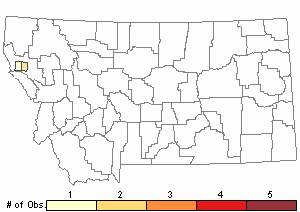
Recency
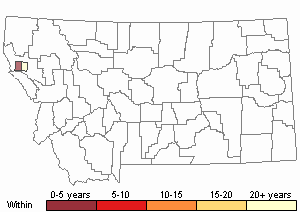

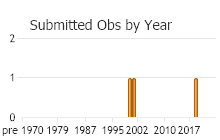
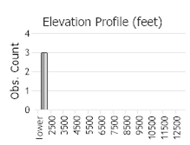 (Observations spanning multiple months or years are excluded from time charts)
(Observations spanning multiple months or years are excluded from time charts)
Habitat
Found in cold, unpolluted, well-oxygenated, permanent, medium-sized streams to large rivers, at least 30 meters and up to 100 meters wide. Habitats are cobble-boulder diatom covered substrate in the main channels, or close to fast-flowing water (rapids), often co-occurring with Fluminicola columbiana (Neitzel and Frest 1989, 1990). This species is not found in areas with a high abundance of macrophytes or epiphytic algae, in areas with a bedrock substrate, or in areas that are dredged or mined (Frest 1999). Fisherola nuttalli occurred primarily in the fastest waters in a Snake River study and the probability of capturing F. nuttalli increased with increasing conductivity from 300-400 (EC) (Richards et al. 2005). This species feeds by scraping algae and diatoms from rock surfaces in the streams. May occasionally feed on other plant surfaces. Dispersal and movement is by a slow snail-like crawl or can be transported by stream current. Present all year, but not active in winter.
Reproductive Characteristics
Freshwater pulmonates generally reproduce by copulation and cross-fertilization. Eggs are laid from spring-fall in gelatinous capsules attached to plants, stones, or other objects. They lack a free-swimming larval stage, and hatch as young snails, anatomically complete except for the reproductive system (Hyman 1967).
Management
Fisherola nuttalli is sporadically distributed at present in the Columbia (formerly widespread) and a few major tributaries in four states and possibly one province. Populations have been lost from most tributaries and almost all the Columbia River itself. It may be extirpated in British Columbia. It has no USFWS status at the present time, but was a candidate for the USFWS Threatened Species status in 1995, recommended by Frest and Johannes. It is currently a US Forest Service Species of Concern (SOC) (G2) and listed imperiled (S1) in Montana and Oregon.
Stewardship Responsibility
Threats or Limiting Factors
Threatened by impoundment and damming (Frest and Johannes 1995). Specific threats to populations of Fisherola nuttalli have been identified as loss of habitat through impoundments, degraded water quality and siltation of cobbles, as well as nutrient enrichment. Effluence from agriculture, industry, and urban and residential developments has reduced water quality in much of the known range (Frest 1999).
References
- Literature Cited AboveLegend:
 View Online Publication
View Online Publication Clarke, A.H. 1981. The freshwater molluscs of Canada. National Museum of Natural Sciences, National Museums of Canada, Ottawa. 446 pp.
Clarke, A.H. 1981. The freshwater molluscs of Canada. National Museum of Natural Sciences, National Museums of Canada, Ottawa. 446 pp. Frest, T.J. 1999. A review of the land and freshwater mollusks of Idaho. Final report to the Idaho Conservation Data Center, Idaho Department of Fish and Game, Boise, Idaho. 281 pp. plus appendices.
Frest, T.J. 1999. A review of the land and freshwater mollusks of Idaho. Final report to the Idaho Conservation Data Center, Idaho Department of Fish and Game, Boise, Idaho. 281 pp. plus appendices. Frest, T.J. and E.J. Johannes. 1995. Interior Columbia Basin mollusk species of special concern. Final report to the Interior Columbia Basin Ecosystem Management Project, Walla Walla, WA. Contract #43-0E00-4-9112. 274 pp. plus appendices.
Frest, T.J. and E.J. Johannes. 1995. Interior Columbia Basin mollusk species of special concern. Final report to the Interior Columbia Basin Ecosystem Management Project, Walla Walla, WA. Contract #43-0E00-4-9112. 274 pp. plus appendices. Hannibal, H. 1912. A synopsis of the recent and tertiary freshwater mollusca of the Californian Province, based upon an ontogenetic classification. Proceedings of the Melacological Society of London X(II):112-165.
Hannibal, H. 1912. A synopsis of the recent and tertiary freshwater mollusca of the Californian Province, based upon an ontogenetic classification. Proceedings of the Melacological Society of London X(II):112-165. Hyman, L.H. 1967. The invertebrates Mollusca I. Volume VI. McGraw-Hill, New York, NY. 288 pp.
Hyman, L.H. 1967. The invertebrates Mollusca I. Volume VI. McGraw-Hill, New York, NY. 288 pp. Neitzel, D.A. and T.J. Frest. 1989. Survey of Columbia River Basin streams for Giant Columbia River Spire Snail Flumincola columbiana and Great Columbia River Limpet Fisherola nuttalli. Technical Report #PNL7103, Battelle Pacific Northwest Labs. 59 pp.
Neitzel, D.A. and T.J. Frest. 1989. Survey of Columbia River Basin streams for Giant Columbia River Spire Snail Flumincola columbiana and Great Columbia River Limpet Fisherola nuttalli. Technical Report #PNL7103, Battelle Pacific Northwest Labs. 59 pp. Neitzel, D.A. and T.J. Frest. 1990. Survey of Columbia River Basin Streams for Columbia Pebblesnail and Shortface Lanx. Fisheries 15(2):2-3.
Neitzel, D.A. and T.J. Frest. 1990. Survey of Columbia River Basin Streams for Columbia Pebblesnail and Shortface Lanx. Fisheries 15(2):2-3. Richards, D.C., M. Falter, G.T. Lester 2005. Additional information request Ar-2-listed mollusks. Report to the Idaho Power Company. Hells Canyon Project FERC No. P-1971-079.
Richards, D.C., M. Falter, G.T. Lester 2005. Additional information request Ar-2-listed mollusks. Report to the Idaho Power Company. Hells Canyon Project FERC No. P-1971-079.
- Web Search Engines for Articles on "Shortface Lanx"
- Additional Sources of Information Related to "Snails / Slugs"





